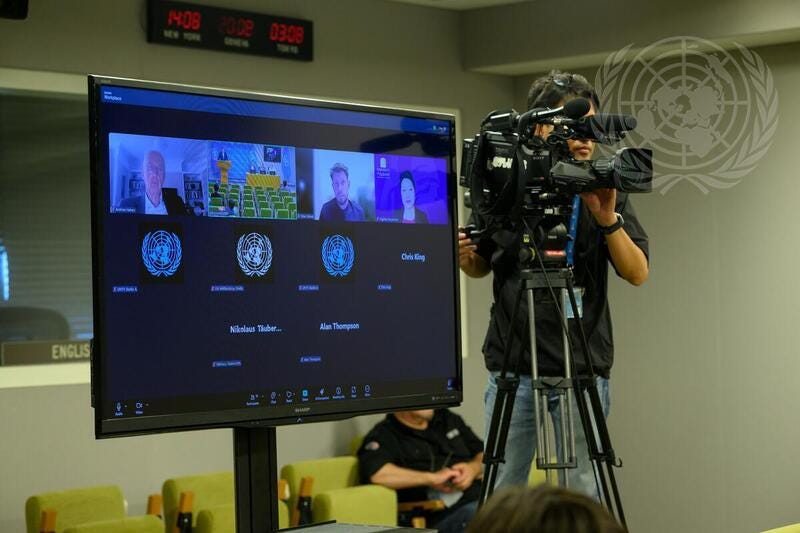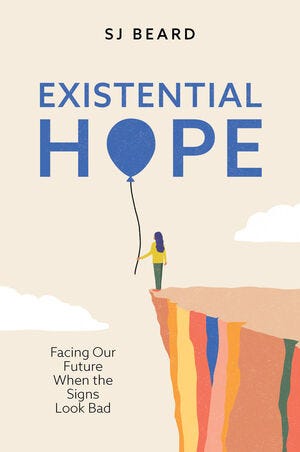Global Shield Briefing (17 September 2025)
Urgency on nuclear risk, multiple layers of defense for AI, and existential opportunity and hope
The latest policy, research and news on global catastrophic risk (GCR).
The critical insight from 2002 book, Ubiquity: Why Catastrophes Happen by Mark Buchanan, is that many catastrophes – whether natural or human-made – share a deep structural similarity. Complex systems can exist in a precarious balance in which small shifts could trigger dramatic outcomes. Decades, or even centuries, of seeming quiet can be disrupted in moments.
Take earthquakes. Deep beneath the Earth’s surface, tectonic plates grind against each other in slow, imperceptible motion. Over time, and in silence, this friction builds, inch by inch, as stress accumulates along fault lines. For years, nothing appears to happen. Then one day, without any obvious warning, the balance tips. A tiny crack propagates, a small slip cascades, and the accumulated tension unleashes its full force in a devastating seismic shock.
Under our feet, the metaphorical tectonic plates of the global order are grinding against each other. Emerging technologies. Geopolitical contest. Military capabilities. Economic reordering. Environmental pressures. Resource supply. Our systems look stable, or at least manageable, on the surface. But they are loaded with hidden fragility.
Before the plates dislocate on a catastrophic scale, we need to step up with urgency, courage, wisdom, and, ultimately, hope.
Creating urgency around nuclear risk

The UN’s Independent Scientific Panel on the Effects of Nuclear War – established under Resolution A/RES/79/238 – met for its inaugural meeting on 4-5 September. The panel brings together leading international experts to evaluate the catastrophic health and environmental consequences of a nuclear conflict. At this first meeting, experts presented on risk to infrastructure, long-term radiation effects, global public health, and global supply chains, among other topics.
Meanwhile, a number of articles point to the precarious global nuclear situation.
An article in the Japan Times neatly summarizes the negative trends in nuclear dialogue and disarmament, including increasingly adversarial nuclear dyads (such as US-China, US-Russia and India-Pakistan), buildup and modernization of nuclear capabilities, and failing institutions. According to the author, an expert in Pacific security issues, “the world is in a grim place when measured by nuclear metrics.”
A global anti-nuclear activist writes in The Diplomat about the role Kazakhstan has played on the nuclear disarmament. She offers concrete steps to reduce nuclear risk, including removing hair-trigger alert for the 2,100 nuclear weapons that can be launched within seconds, reaffirming the moratorium on nuclear testing, and preventing new frontiers of nuclear contest, like space and AI.
The New Yorker looks at why the public and policymakers do not take nuclear weapons as seriously as during the Cold War. The article focuses on the psychological aspects of nuclear war, given that so much authority is vested in the hands of national leaders, that deterrence relies on a perceived rationality of the opponent, and that the dynamics of personal relationships (between political leaders, or between crews operating nuclear-capable assets) are critical in moments of crisis.
A defense analyst notes that “while China, Russia and North Korea have been “Arms Racing” since the end of the Cold War, the U.S. has been a side-line observer, and the current long delayed U.S. strategic force modernization program is replacing systems ageing out on a one-for-one basis.” A recent Foreign Affairs piece states that the US faces “a Category 5 hurricane of nuclear threats.”
Policy comment: Baseline nuclear risk is as high as it has ever been outside of temporary nuclear crises, like the Cuban Missile Crisis. And the risk will almost certainly grow over the next ten years. The core drivers of nuclear risk are all moving in the wrong direction: expansion and modernization of nuclear arsenals, intensifying geopolitical competition, potentially destabilizing emerging technologies, and growing global instability. And these factors outweigh those that keep the risk in check – multilateral institutions, taboos and norms, and pressure from non-nuclear states and civil society. Yet, despite this reality, the public, and most policymakers around the world, are not sufficiently aware of the level of risk, now or in the near future. Non-proliferation efforts are not receiving adequate attention or urgency, and will only become less effective over time. As the Japan Times article states, “We’ve reached the point where some experts believe that we need a genuine crisis to alert officials and publics to the problem and create a sense of urgency.”
Building multiple layers of defense for AI risk

Many governments are leaning heavily into pro-innovation stances in 2025. This shift is mostly shaped by a global race to remain competitive (and less of a ‘price-taker’ in AI), as well as precarious economic conditions around the world putting more onus on maximizing the opportunities. For example, since the start of the year, South Korea and Japan both legislated an AI Law, and steered it away from safety, and are focusing on making substantial investments in AI infrastructure and innovation. Germany is already pushing back against the regulation-forward implementation of EU AI Act. Australia, which was seriously contemplating a comprehensive AI Act late last year, has become much more circumspect, and is more likely to pursue an innovation-forward agenda without significant regulatory oversight.
Despite these trends, there are pockets of effort to retain AI safety on the agenda. Managing to navigate geopolitical uncertainty and multilateral blockers, the UN recently established the UN Independent International Scientific Panel on AI and the Global Dialogue on AI Governance. China’s government has been treating AI safety as a national security and public safety issue. Singapore, looking to play a greater convening role in global and regional AI governance, hosted the Singapore Conference on AI (SCAI): International Scientific Exchange on AI Safety, which resulted in the “Singapore Consensus on Global AI Safety Research Priorities”. And Brazil is currently debating a new AI Legal Framework Bill, which includes a commitment to safety and trust, such as a Competent Authority designated for oversight.
Policy comment: The growing emphasis on AI adoption as a driver of economic growth will probably slow or reduce the political feasibility of strict AI safety policies and frameworks. As a result, efforts to regulate AI comprehensively or through a single act might not be the most effective approach for advocacy. Instead, a range of more targeted policy efforts could create a “Swiss cheese model” of AI risk management - whereby multiple layers of defense can help protect from AI risk without the necessary political will for a more robust framework. For example, reducing AI risk from different angles can include: upgrading existing legislation (such as competition and privacy laws, consumer safety regulations, and transparency measures), focusing on the ability for state and non-state actors ability to create weapons of mass destruction, improving government use and procurement of AI, and enhancing crisis planning and last resort powers in case of emergency. Even in countries where legislation is either set or firming up, advocates can play an important role in shaping the implementation and future upgrades to the legislation. However, these advocacy efforts remain relatively limited, focused on the US and some European and Western countries.
Maximizing existential opportunity and hope

In a new report on existential risk, the Club of Rome is proposing a new paradigm: planetary peace. It notes that “Our existing international governance and security frameworks were not designed to address the modern and escalating risks we now face. Furthermore, in many ways those inherently siloed frameworks have caused or aggravated the very risks they are meant to manage. They are profoundly limited in their capacity to effectively prevent or reduce the existential threats facing humanity today.” It goes on to say that “Recognising existential risks not only alerts us to the many threats and challenges facing humanity but also unveils “existential opportunities” that could fundamentally change the trajectory of our collective future.”
A new book on existential hope has been released by Dr. SJ Beard, an existential risk researcher from the Centre for the Study of Existential Risk. For Dr. Beard, “achieving existential security and sustainability for our species requires systemic solutions that are adaptable and long-lasting.” Existential hope is characterized by “courage (to acknowledge these problems), curiosity (to understand them) and compassion (to work on solving them together).”
Policy comment: These concepts – planetary peace, existential hope – might seem far-fetched, or even off-putting, to policymakers. However, this reaction points to the exact problem these thinkers are trying to solve; if the very phrasing strikes many as fanciful, then humanity has clearly reached a state of global risk where a fundamental rethink of our approach to security might be necessary, regardless of how you describe and brand it. In financial investment circles, the saying goes: “Protect the downside and the upside will take care of itself.” But that adage does not work for global risk. Reducing existential risk is necessary, but ultimately incomplete, work. It goes hand-in-hand with building a future for all countries, cultures and peoples to thrive. From a policymakers’ perspective, it might require different arms of government, different styles of communication, and different parts of the national consciousness. Where risk management leads a policymaker to certain ways of governing – security, defense, emergency management, environmental protection – opportunity and hope maximization leads them in other directions – culture, arts, economics, education, civics. The nations that will both survive and thrive in the 21st century will be led by policymakers who can marry these two priorities.
This briefing is a product of Global Shield, an international advocacy organization dedicated to reducing global catastrophic risk of all hazards. With each briefing, we aim to build the most knowledgeable audience in the world when it comes to reducing global catastrophic risk. We want to show that action is not only needed, it’s possible. Help us build this community of motivated individuals, researchers, advocates and policymakers by sharing this briefing with your networks.

